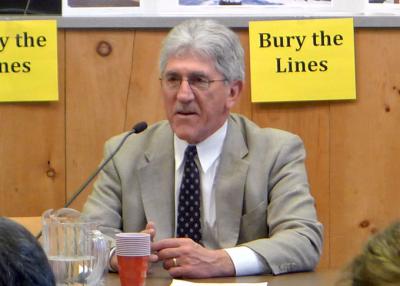Cantwell Will Not Seek Third Term as East Hampton Town Supervisor
Cantwell Will Not Seek Third Term as East Hampton Town Supervisor

East Hampton Town Supervisor Larry Cantwell announced on Friday that he would not seek a third term.
The announcement was made at a meeting for reporters who had been invited to join him at Goldberg's Famous Bagels in East Hampton. Mr. Cantwell, a Democrat, said that after weighing his options over the holidays, he decided he wanted to spend more time with his family and enjoy life.
Mr. Cantwell said that in his two terms as town supervisor he had put the public's interest first and that his personal and private interests had "taken a backseat." He said he had no specific plans for what would be next for him.
Mr. Cantwell said that, if anything, the election of Donald J. Trump as president would have motivated him to stay on.
He said he plans to work hard for the remainder of his term, which lasts through December. Mr. Cantwell said he has enjoyed every part of the work he has done as supervisor.
Councilman Peter Van Scoyoc said that Mr. Cantwell had spoken to him about his decision on Thursday evening. "I am disappointed that he will not be seeking another term. Larry has done a terrific job as supervisor, and the town is in great shape right now," he said.
Among Mr. Cantwell's priorities for the remainder of his term is to get a law adopted that would help residents upgrade cesspools and inadequate septic systems, which are polluting groundwater and harbors and bays.
He wants to press the Army Corps of Engineers on its Montauk beach replenishment project. He said that the next steps will include a maintenance plan prepared by the town; he said it remains to be seen if the Corps will listen.
Regarding the airport, the town acted with good faith and worked diligently to get noise restrictions in place, he said.
He wants to continue to press the state and the Long Island Power Authority to approve offshore wind turbines. He said he hopes to get Deepwater Wind, the company that hopes to build a new wind farm, to Montauk to meet with fishermen to address their concerns.
Mr. Cantwell said he feels good about having established a constructive dialogue between members of the board and the public, something he thought was especially needed given the previous town board. "The board has been focused on problems; the public is engaged in making decisions," he said.
Mr. Cantwell said that had spoken with other members of the town board regarding a successor. He said it makes sense to look to the incumbent members of the board. The town supervisor's post is a two-year term.
Mr. Van Scoyoc said that he was considering a bid for the post. Councilwoman Kathee Burke-Gonzalez, a Democrat, said Friday that she would not be interested in running for supervisor.
Councilman Fred Overton, a Republican, whose term is coming to a close, has said he will not seek re-election.
Sylvia Overby, who holds the remaining seat on the five-member board, could not be reached on Friday morning to gauge her interest in a bid for Mr. Cantwell's post.
Mr. Cantwell was elected to his second term as supervisor in November 2015 by a wide margin over Tom Knobel, the Republican candidate. That year's race was notable as the most expensive ever in East Hampton Town, as hundreds of thousands of dollars were spent by aviation interests to attack the Democratic candidates, who favored tight restrictions at East Hampton Airport.




